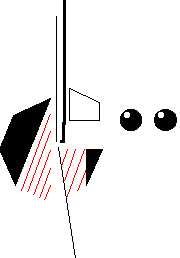

The GRETSS**, a new
team
|
[ home] [French societies] [security] [engines] [1977 - 1983 projects] [1983 - 1993 projects] [Paral'bol 1993 - 1996] [Céphéide 1996] [another sites]
[Parathon'air]
[PLQMTM] [Ibex] [Résolution] [Marie-Antoinette] [Storig] [Minifarad] [Horus] [Promethée] [Arcadia] [Fox]
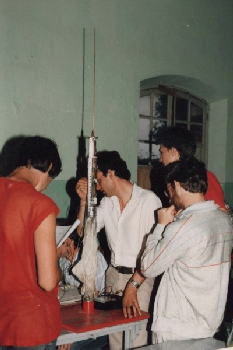
| In August 1983 three new members of the club had
participated (François, Simon & Michel) in a summer
camp for experimental rocket building where they had
developed a rocket recovered by an "umbrella"
(PARAZIT). Although the electronic had worked perfectly,
the mechanical construction lacked strength. As a result of this experience the PARATHON'AIR came into being. The club was strengthened with the Jeff & Papy & so the club GRETSS* became GRETSS**. A bambi was chosen as the motor to simplify construction & since it was well adapted to the size of the project. The only negative point was that launch accelerations were in the region of 20G, requiring a very solid construction. |
Parathon'air at the Ruchard with Papy (center in white), Gretss ' and Jean-L'ouille
The project incorporated 2 innovations for a rocket of this size:
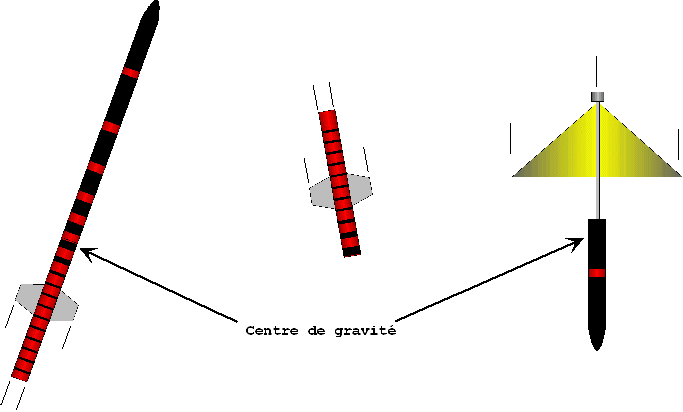
With a 3.5kg lift off weight, 63mm diameter & 1.4m length a peak altitude of 1200m after 13 seconds was calculated.
The launch took place at the Ruchard military camp. Despite a nominal lift off a gust of wind flattened the trajectory. As a result of this the rocket developed a much higher horizontal velocity than desired. So after 13 seconds when the umbrella was deployed the rocket experienced a very sharp deceleration & shock. This caused the telemetry system (which had functioned perfectly up to this point) to reset, resulting in no useful data being returned after this point. Additionally, the umbrella was seriously damaged during deployment & failed to decelerate the rocket sufficiently. As a result, Parathon'air impacted far from the launch site & was never found
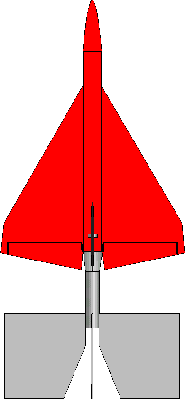
| PLQMTM (Plus Lourd Que Moi
Tu Meurs) fût la première d'une longue
série de navettes réalisée par le GRETSS**. L'idée de base était de construire un engin dont la récupération ne poserait pas de problème (cf. PLEONASME2 et L'APLUBEL). Les navettes étant alors à la mode (on parlait beaucoup du Space Shuttle et déjà d'Hermès) et permettant en théorie de ramener l'engin à l'endroit désiré, le club décida (en même temps que le CAC ) de se lancer dans l'étude d'un tel engin. Comme vous pouvez le constater sur le schéma, PLQMTM est composée de 2 parties distinctes qui se séparent à culmination :
Ce choix (qui s'avéra mauvais en fin de compte) vint d'une remarque toute simple : Pour voler en phase ascendante, une fusée doit avoir une marge statique comprise entre 1 et 3, alors que celle d'un planeur doit être quasiment nulle. Il paraissait alors logique de faire un planeur correctement équilibré et de lui adjoindre un étage propulseur munis d'énormes ailerons pour faire redescendre le centre de poussée. En théorie, cela peut fonctionner, mais cela pose de très gros problèmes de réalisation. Il est très délicat de fixer des ailerons de 60 cm de coté (en balsa et fibre de verre) sur une virole de 10 cm en aluminium, et je ne parle pas des performances d'une telle configuration. De plus, cette navette employait des techniques de constructions adaptées aux fusées (tube PVC, structure des ailes en bois et aluminium), mais inadaptées pour un planeur. Le résultat fût un engin très lourd (plus de 14 Kg, d'où son nom) et très fragile. |
Le tir eu lieu en août 1985 au Ruchard et la navette se disloqua en fin de propulsion. Le pilote n'eut pas l'occasion de tester les réactions de l'engin en vol.
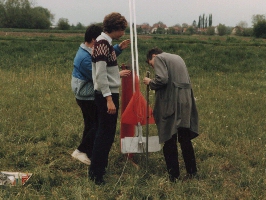
| Une maquette animée par un micro-propulseur a été
réalisée pour valider la stabilité en vol. Elle se
trouve sur une rampe spéciale avec Jeff au centre et
Sakapus à droite |
After Parathon'air and PLQMTM a simple & reliable project was developed & again a Bambi was chosen for propulsion.

Technical data:
2 telemetry channels using IRIG encoding :
A sequencer / timer (using a 4060 chip) to activate the PPUK igniter. |
IBEX décollera le 24 août 1985 à 16 heures du camp militaire de Mourmelon.
En 11 secondes, la fusée arrive à culmination (800 mètres). Mais pas de parachute. Que se passe-t-il ? Après de longues secondes d'attente (la minuterie s'était déréglée), le parachute sort enfin et la banderole est libérée. La PPUK est donc qualifiée et pourra être installée dans d'autres projets.
La télémesure subit elle quelques problèmes.
Bref, ce n'est pas la gloire !
Mais l'objectif premier a été atteint, le
club a tiré une fusée en 1986 et il n'est toujours pas mort.
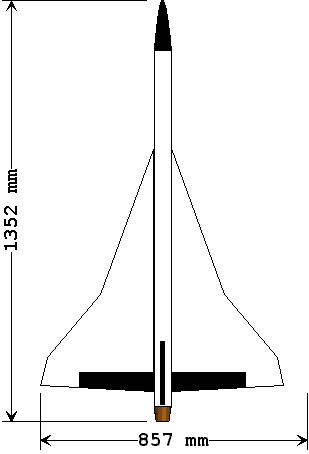
| A 1/2 scale model of a proposed experimental rocket
boost glider (Storig), to test the stability &
aerodynamic properties of the larger vehicle. The objectives of resolution were two fold:
Technical data 85cm span, in the form of a double delta, using a NACA 0006 airfoil and 1.050kg all up weight Wings constructed from Polystyrene foam & balsa, covered with Solarfilm. Glass fibre body tube, with wooden nose cone. No active guidance system, but a timer was used to move the elevators at the end of the boost phase of the flight. The timer activated a pyrotechnic device which released a elastic cord leading to elevator deployment 200m maximum altitude after 4 seconds of flight Specially constructed 3m (10ft) launch ramp |
| Resolution was flown twice (first flight (in 7 photo) with a dik-dik, second with a Koudou). The boost glider functioned perfectly, with a stable flight gliding in concentric circles. |
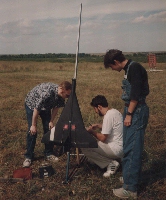
| It will be relaunched a third time in Mourmelon. (August 1991) painted in black, powered by a Koudou. But this time, a remote control was embeded. |
Based on this success the development
of Storig was started.

| MARIE-ANTOINETTE (1987 Freluquet, JFK
and Manu) It was the first rocket of this new team. Because of lack of documentation, I can't explain a lot about it. If I remember correctly, Marie-Antoinette was powered by an Isard and carried 2 telemetry chanels. Elle fit un vol balistique car la vis de sécurité qui maintient la fusée en une seule partie (au cas ou les goupilles sortiraient prématurément) n'a jamais été enlevée. La fusée est partie avec, les goupilles sont sans doute sorties à culmination, mais la fusée ne s'est jamais séparée. |
en cours de rédaction
An elegant experimental rocket boost glider 2.42m long, with a double delta planform. This was propelled by a Chamois motor & radio controlled from the ground .
Storig was launched on 27 August 1988 at Mourmelon.
Sadly, Storig broke up at the end of the propulsive phase
after 2.5 seconds of flight due to aerodynamic / structural
overload.
A small but original design, built from condenser tubes. The objective of this design was to miniaturise many of the systems found in experimental rockets to fit into a mini rocket propelled by a Koudou (A G/H class motor).
Technical data:
Maximum altitude of 500m after 8 seconds of flight (August 1989 launch at Mourmelon)
 A day when Miloux was out of beer, he
had an idea.Generally, when he's out of beer, he bougth some new
bottles. But this day, he decided to realize all alone its own
rocket
A day when Miloux was out of beer, he
had an idea.Generally, when he's out of beer, he bougth some new
bottles. But this day, he decided to realize all alone its own
rocket
More mechanic than electronic, he decided to carry 4 IRIG chanels in an Isard :
Construction from PVC tube, 1.9m long by a 63mm diameter. 4.7kg lift off weight.Recovery by a parachute deployed by sequencer / pyrotechnic device
Horus was launched at Mourmelon using an Isard motor & reached a peak altitude of 1800m after 18 seconds of flight. At this point the parachute opened & the rocket descended slowly to earth during 2m20seconds.
Unfortunately only acceleration & temperature data could be decoded due to a shift in transmitter frequency during launch (caused by a potentiometer coming loose)..
.
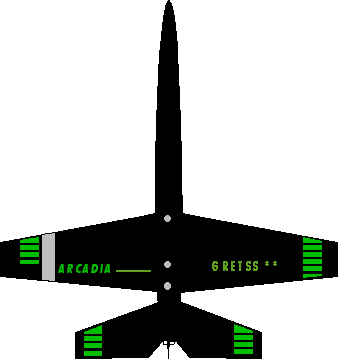
| Début 1991, Michel décide aussi de
faire une navette propulsée par un Koudou. Arcadia se caractérise par une aile trapézoïdale associée à un profil porteur. Elle dispose aussi de trois ailerons arrières disposés à 120°. Des maquettes en micro-fusée démontreront la bonne stabilité de l'engin en vol plané. Sa structure est faite de styro entoilé de fibre de verre. C'est à la fois léger et solide. Une télécommande permet d'actionner les 2 gouvernes placées en bas des ailes. Elle sera tirée en août 1991 lors d'une campagne régionale à Stutzheim (comme ça s'éternue, à 15 Km de Strasbourg) sous les caméras de FR3 national (résultat, 2 minutes de reportage diffusés diffusé dans "une pêche d'enfer") Le vol de cette mini navette ne sera pas aussi concluant que celui de ses maquettes. Peut après le départ, elle dévie de sa trajectoire et se met sur le dos. Ne disposant que de gouvernes sur les ailes, le pilote (JFK) ne pourra malgré tout ses efforts et sa superbe radiocommande la remettre dans le droit chemin. Elle finira par s'écraser tristement au sol. |
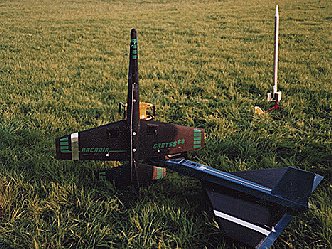
| ARCADIA et PROMETHEE IV sur l'aire de lancement peut avant le départ |
en cours de rédaction
 This rocket was built by Francois
& two other students as technical project for their
studies. The key features of this rocket were a pneumatic
gyroscope, to measure the rotation rate of the
rocket & very fine construction. This rocket was built by Francois
& two other students as technical project for their
studies. The key features of this rocket were a pneumatic
gyroscope, to measure the rotation rate of the
rocket & very fine construction.1550mm long, with a maximum diameter of 120mm. Total weight of 12kg. Chamois motor, giving a maximum altitude of 1200m after 16s. Parachute deployed by a pyrotechnic system with transversal separation. Moulded conical nose & boatail sections joined to a central aluminium section. The moulds used to make these sections were fabricated using a programmable lathe. A fantastic surface finish / paint job. No external screws |
The gyroscope was invented by Foucault in 1852 to demonstrate the rotation of the earth & the laws of pendulum motion.
Any body which has a rapid rotation rate can be considered as a gyroscope. The properties of a gyroscope are due to an angular momentum caused by centrifugal force in the rotating mass.
If the gyroscope is not subject to a prolonged force it will maintain the same axis of rotation in space.
However, if a continuous substantial force is applied to the gyro one of two things will happen depending on whether the axis of rotation is constrained or not.
To measure the rotation of the rocket around its axis during flight to maximum altitude the gyro must turn at a very high rotation rate (30,000 rpm or more) to give an accurate measurement.
Therefore, three different methods of spinning up the gyro were studied :
Using the air gyro system it was possible to spin a 20mm gyro wheel up to 60,000rpm (the rotation limit of the bearings) using a 6 bar air supply flowing through a 1.6mm needle which acted on a series of blades on the edge of the gyro.30 seconds after the air flow was cut the rotation rate was still greater than 30,000rpm.
On the launch ramp air was supplied to the gyro through an umbilical up to a few seconds before launch, when the umbilical was retracted using a pyrotechnic device.
A low mechanical resistance potentiometer was used to measure
rotation of the gyro through 360 degrees. Rotation rate data was
to be downlinked using an IRIG encoded telemetry system & a
transmitter provided (IBIS) by ANSTJ.
After 2 years of effort, Fox was ready for flight at the annual CNES / ANSTJ launch campaign in August 1993. The rocket had passed all safety tests with flying colours, but was finally not launched due to a logistical problem during the launch campaign!
[Parathon'air] [PLQMTM] [Ibex] [Résolution] [Marie-Antoinette] [Storig] [Minifarad] [Horus] [Promethée] [Arcadia] [Fox]
[ home] [French
societies] [security] [engines] [1977
- 1983 projects] [1983 - 1993 projects] [Paral'bol
1993 - 1996] [Céphéide 1996] [another
sites]
http://www.multimania.com/gretss/